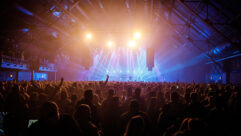On this edition of the SVC Podcast, Contributing Editor Bennett Liles talks with Chris Austin, Technical Sales Manager at Autograph Sales and Installations about their work on the United Kingdom’s first Meyer Sound LINA speaker system at London’s Cadogan Hall. Home to the London Symphony Orchestra and visited by an increasingly wide range of musical performers, Cadogan Hall needed a detailed sound upgrade to coincide with increasing its seating capacity.
Links of Interest:
· Autograph Sales and Installations
· Meyer Sound LINA compact line array speaker
· Yamaha CL Series digital mixers
Home to the London Philharmonic Orchestra, Cadogan Hall also hosts a wide range of other performers. They needed a new sound setup to increase seating and make the hall more versatile. Autograph Sales and Installations put in a new LINA speaker system from Meyer Sound and a Yamaha CL3 digital mixer. Technical Sales Manager Chris Austin has the story next on the SVC Podcast.
Chris, it’s good of you to accommodate the time zones to get with us for the SVC Podcast from London today. Autograph Sales and Installations Technical Sales Manager which probably means just about anything they want you to do.
[Laughs] Exactly. Thank you very much for having me along.
Alright and we have a complete sound system renovation for London’s very busy Cadogan Hall. Before we get to that tell us about Autograph Sales and Installations. It’s been a couple of years since we did one of these with Autograph so what’s been going on there since then.
We’ve been keeping pretty busy. Autograph Sales and Installations is the sister company of Autograph Sound. They’re well known for their theater rental work, we focus on sales and installations, or increasingly integration; probably what you’re supposed to call it. Our core market is theater, but we do a lot of work in education, house of worship, corporate stuff, but increasingly into more varied markets like retail and hospitality. [Timestamp: 1:34]
OK, good to stay loose and be ready for anything that might come along but I would think that the theater projects might be some of the more challenging ones.
Yeah, they can be. It’s interesting when people bring a challenge to us. I like to think what we do doesn’t change. Someone has a message that they want to communicate very clearly with a high quality. They don’t all call it a production, but it’s all a production of sorts. [Timestamp: 2:00]

And the recent one was at London’s Cadogan Hall. I’ve been through a bunch of YouTube videos on that place and they have a lot of very different performances all happening back to back. To make the hall more versatile there’s been a new seating arrangement and a big update to the sound system.
Exactly. So new seating arrangement, new PA and new desks and infrastructure over the years. So we’ve worked with Cadogan since they opened back in 2004, so the building itself has been there since early 1900’s, but it was a church. But it got bought and converted to a concert hall in 2003-2004. So we didn’t do the original install but we worked with the integrator that did so in our capacity as a Meyer Sound partner we helped them come up with the design for the PA – the original PA that went in – and some of the surrounding systems. And I believe we were also involved in tuning it back then. But between when they opened and now the program, as you say, has become a lot more diverse. So they’re the home of the Royal Philharmonic Orchestra and they still do an awful lot of classical and orchestral program, but they also do a lot of contemporary jazz. They do a little bit of sort of private-hire/corporate-hire events as well. So what original went in was a very good system at the time, but the brief of what it needs to cover has evolved and that brought around the desire to upgrade. [Timestamp: 3:31]
I think they’re up to, what is it, about a thousand seats now?
Yeah. So the seating changes they had were they had a very large and luxurious front-of-house position at the front of the balcony that accommodated their old desk and racks and racks of equipment. That came out as part of the changes and a new upper balcony was put in purely for technical services; so for the lighting desk and a small sound console and video bits. So that gave them lots of seats back on the balcony and then they added infrastructure for a temporary front-of-house position in the stalls. [Timestamp: 4:10]
I think a new Yamaha CL3 was selected for the front of house mixer. Why was that particular one chosen?

So the old desk they had, there’s some history behind it. It was one of the first Yamaha PM1D’s in the country installed permanently in a venue at the time. So that’s something they were very comfortable with. They’re very comfortable with Yamaha as a brand. For the type of shows that came in, Yamaha is a very recognized name that everyone can get behind quite easily. The other parameters that informed that were the Dante networking and the flexibility of being able to put the consoles and the stage racks in a variety of places. So the stage racks are fairly fixed. They’re built into – or sort of hidden into enclosures around the stage and there’s some in the patch room. But because they have now a movable front-of-house position, the ability just to plug in the CL at the back of the stalls on a couple of cables rather than huge looms and multicores is very convenient because on shows that aren’t very demanding from a sound point of view – like a more unamplified orchestral show that just has a bit of a speech from the conductor or maybe a corporate presentation – they’ll be mixed from the balcony so they don’t lose any seats at the back of the stalls. [Timestamp: 5:33]
OK, this one appears to have been done in stages and the most recent change was the addition of the new Meyer Sound LINA speaker system to deal with the more broad range of musical shows.
Yes. So the LINA went in in the summer. So that’s something we’ve been talking about for a long time. Some sort of PA upgrade has been on the cards for a while at various points that evolved from whether more boxes got added to the old system, whether it got rearranged, whether we moved it. But then the LINA was released and we did a demonstration in the hall because we thought it would be right up their street. And it worked very, very well and it all moved quite swiftly from there. But we were very lucky that because we had already been having conversations about what the future of the PA would be when we had done some previous infrastructure work when the seating was changed and the front-of-house position was moved. We had upgraded some of the infrastructure to the arrays in the roof and added some cabling into the front of the stage ready for a potential upgrade, which made the actual process of doing the upgrade this summer very simple. [Timestamp: 6:42]

And that probably saved considerably on space and maybe opened up the stage a little more for better sightlines.
A bit of both. So what they had previously was Meyer M1D flown in two hangs on either side of the stage as well as some point source boxes, so CQ1’s and subwoofers on the stage, to provide more energy into the stalls when they were doing louder, contemporary, amplified shows. So the aim of the new design was to take away the need to have large fill boxes on the stage and to cover the whole system from the flown arrays. The LINA is a lot narrower than the M1D it replaces, albeit it’s a little bit deeper, so even though there are more of them and the array is longer, it’s thinner which helps with sightlines – not to the stage, but mainly to their projection screen. They have a very large projection screen at the back of the stage which they use for some events. So it improves that, but it also frees up some much needed stage space because when they’re doing something like a semi-staged opera and you’ve got a full orchestra on the stage but also the need for a loud PA, losing space on the stage to piles of speakers and subwoofers is undesirable. It’s also fairly uncomfortable for the musicians, which is becoming a hotter topic. [Timestamp: 8:04]
I think you also added at some point a QSC Q-SYS DSP core in there so how does that work for the versatility of the hall?
So we put the QSC in at the same time as putting the first Yamaha CL3 in. So it replaced an old Media Matrix system that had served them very well for a long time. We replicated quite a lot of the functionality that they had before and then added some extra bits. So the main benefit of it is it’s providing system processing to the PA. There’s an awful lot of speakers in the room. It’s a horseshoe balcony but there’s still a small overhang so there’s a lot of delay speakers under the balcony which were retained from the original system into the new system. The Q-SYS also handles some building paging functions. It receives inputs from their existing paging systems so they can do things like page to the auditorium. It generates all the show relay feeds that go backstage into the dressing rooms. So it provides them a lot of sound management functionality. [Timestamp: 9:09]
They’re relying heavily on the LINA speaker system. With over 300 shows a year that doesn’t allow much down time for adjustments and fixes.
No, exactly. We try to keep that in mind with all of our installations because there’s not many people that can afford down time, but Cadogan in particular is a very, very busy venue so it is tricky to get in and do major maintenance if you need to. We did the infrastructure install with that in mind in order to address some of the issues they had in the past, but also just to be very well prepared for what the worst case could be. So in order to try and keep things as reliable as possible, for example, the audio from the Yamaha system into the Q-SYS is actually AES – it isn’t Dante – directly in so that means if a visiting artist brings their own console, if it’s a Yamaha console they can just pick up the venue’s rear rack that’s in the patch room and they don’t have to repatch. Or they can patch into XLR inputs direct into the Q-SYS but don’t have to do any work that could compromise the audio network. [Timestamp: 10:13]
It’s been interesting on how you got started with this and the various stages of the project. In Part 2 we’ll get into how you actually got the system in there, the rigging and the Meyer RMServer. We’ve been talking to Chris Austin, Technical Sales Manager for Autograph Sales and Installations about London’s Cadogan Hall sound system changes. Chris, thanks for getting with us for this one.
Thank you very much. It’s been a pleasure.
So now Cadogan Hall is ready for anything they can book and the new sound system allows a bigger audience to enjoy the shows. Thanks to Chris Austin and Autograph Sales and Installations for telling us all about it. Next week, Chris will be back to talk about the array rigging and the Meyer Sound RMServer. Next time on the SVC Podcast.










